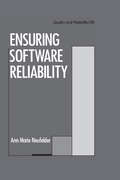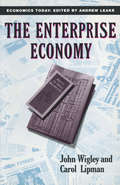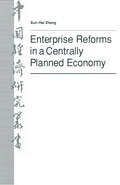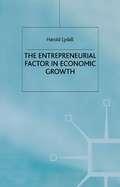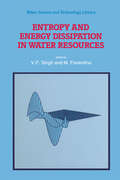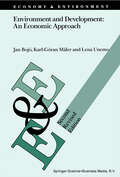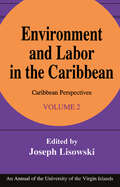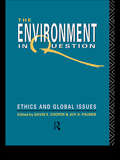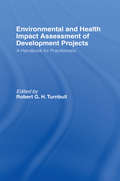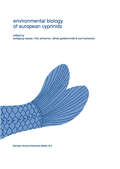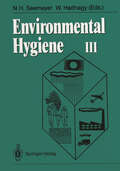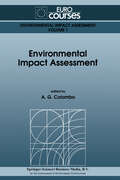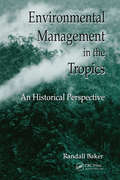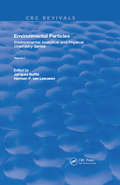- Table View
- List View
English Poetry of the Seventeenth Century
by George ParfittProvides a comprehensive and entertaining account of the vitality and variety of achievement in seventeenth-century English poetry. Revised and up-dated throughout, Dr Parfitt has added new material on poets as varied as Marvell and Traherne. There is also a completely new chapter on women poets of the seventeenth century which considers the significant contributions of writers such as Katherine Philips and Margaret Cavendish. The proven quality and success of Dr Parfitt's survey makes this the essential companion for the teacher and student of seventeenth-century verse.
Enrique Granados: A Bio-Bibliography (Bio-Bibliographies in Music)
by Carol A. HessEnrique Granados (1867-1916) was one of the first modern Spanish composers to achieve international recognition. During a 1916 visit to the United States his opera Goyescas was premiered by the Metropolitan Opera and his symphonic poem, Dante, by the Chicago Symphony. Granados was also especially admired in Paris, where he knew Saint-Saens, d'Indy, and Faure. He had composed a remarkable body of work and was also at the height of his career as a concert pianist at his untimely death while a passenger on a torpedoed British ship.The biographical study, the first in English, draws on primary sources in English, Spanish, French, Catalan, and other languages. This material is carefully documented in the extensive annotated bibliography along with contemporaneous and recent analytical studies and other sources. Granados's oeuvre presents cataloging problems due to his habit of reworking pieces, long-delayed publication, and arbitrary opus numbers. In the Works and Performances section, however, every effort has been made to offer publication dates, manuscript locations, and information on premieres. Representative arrangements of his works by other composers are also given. An appendix classifies the works by scoring. A selective discography is also provided, and all parts of the volume are fully cross-referenced and indexed. Granados is placed in the context of the international artistic scene at the turn of the century, and a chronology notes related events.
Ensuring Software Reliability (Quality and Reliability)
by Ann Marie NeufelderExplains how software reliability can be applied to software programs of all sizes, functions and languages, and businesses. This text provides real-life examples from industries such as defence engineering, and finance. It is aimed at software and quality assurance engineers and graduate students.
Ensuring Software Reliability (Quality and Reliability)
by Ann Marie NeufelderExplains how software reliability can be applied to software programs of all sizes, functions and languages, and businesses. This text provides real-life examples from industries such as defence engineering, and finance. It is aimed at software and quality assurance engineers and graduate students.
The Enterprise Economy (Economics Today)
by Carol Lipman John WigleyDuring the 1980s and continuing into the 1990s Enterprise became central to the economic agenda and was seen as a solution to a range of economic problems. This book discusses the main approaches to enterprise and examines the relationship between entrepreneurs and capitalism. It provides detailed studies of the policies pursued by the Conservative government in the UK. Since 1979, with regard to markets, small firms, regional policy, enterprise zones, deregulation, privatisation, etc. and ends with a review of the enterprise culture.
Enterprise Reforms in a Centrally Planned Economy: The Case of the Chinese Bicycle Industry (Studies on the Chinese Economy)
by Zhang Xun-HaiSeeks to analyze China's industrial reform in the 1980s by examining the Chinese bicycle industry. It sets the changes since 1978 into historical perspective by giving an account of the development of this industry.
Enterprise Unionism In Japan
by Hirosuke KawanishiDuring the 1980s many Japanese began to feel the pressures of ‘internationalizing.’ At the same time, Japanese-style industrial relations came to receive wide international attention. For most people ‘Japanese-style industrial relations’ came to mean the ‘three sacred treasures’: lifetime employment, seniority wages and enterprise unionism. During the 1980s many Japanese began to feel the pressures of ‘internationalizing.’ At the same time, Japanese-style industrial relations came to receive wide international attention. For most people ‘Japanese-style industrial relations’ came to mean the ‘three sacred treasures’: lifetime employment, seniority wages and enterprise unionism.
Enterprise Unionism In Japan
by Hirosuke KawanishiDuring the 1980s many Japanese began to feel the pressures of ‘internationalizing.’ At the same time, Japanese-style industrial relations came to receive wide international attention. For most people ‘Japanese-style industrial relations’ came to mean the ‘three sacred treasures’: lifetime employment, seniority wages and enterprise unionism. During the 1980s many Japanese began to feel the pressures of ‘internationalizing.’ At the same time, Japanese-style industrial relations came to receive wide international attention. For most people ‘Japanese-style industrial relations’ came to mean the ‘three sacred treasures’: lifetime employment, seniority wages and enterprise unionism.
Entranced: The Donovan Legacy (Donovan Legacy #No. 2)
by Nora RobertsAVAILABLE DIGITALLY FOR THE FIRST TIMEPrivate investigator Mel Sutherland is running out of time. A child has been abducted and despite Mel's valiant efforts, all the leads have dried up. So she can hardly blame the child's desperate mother for seeking help from so-called psychic Sebastian Donovan. But that doesn't mean Mel is going to trust him - not one inch. Sebastian knows that Mel thinks he's just a con artist, exploiting a grieving mother's vulnerability. He also knows that he's the only one who can help her, if she'll just listen to her instincts - and her heart...Entranced can be read as a bewitching standalone novel. It is also the second book in The Donovan Legacy, which features cousins Morgana, Sebastian, Anastasia and Liam. The series begins with Captivated and continues with Charmed and Enchanted - all now available as eBooks for the first time.Includes a preview of Charmed.
The Entrepreneurial Factor in Economic Growth
by H. LydallA crucial factor in economic growth - the supply of entrepreneurship - is largely neglected in modern economic theory. The main reason is that the theory is dominated by the model of perfect competition, which logically excludes any function for the entrepreneur. The standard model is also inconsistent with several obvious facts. Instead, the author proposes two alternative models of 'entrepreneurial competition', one for conditions of near-perfect competition in product markets and the other for imperfect competition in those markets.
Entropy and Energy Dissipation in Water Resources (Water Science and Technology Library #9)
by V. P. Singh M. FiorentinoSince the landmark contributions of C. E. Shannon in 1948, and those of E. T. Jaynes about a decade later, applications of the concept of entropy and the principle of maximum entropy have proliterated in science and engineering. Recent years have witnessed a broad range of new and exciting developments in hydrology and water resources using the entropy concept. These have encompassed innovative methods for hydrologic network design, transfer of information, flow forecasting, reliability assessment for water distribution systems, parameter estimation, derivation of probability distributions, drainage-network analysis, sediment yield modeling and pollutant loading, bridge-scour analysis, construction of velocity profiles, comparative evaluation of hydrologic models, and so on. Some of these methods hold great promise for advancement of engineering practice, permitting rational alternatives to conventional approaches. On the other hand, the concepts of energy and energy dissipation are being increasingly applied to a wide spectrum of problems in environmental and water resources. Both entropy and energy dissipation have their origin in thermodynamics, and are related concepts. Yet, many of the developments using entropy seem to be based entirely on statistical interpretation and have seemingly little physical content. For example, most of the entropy-related developments and applications in water resources have been based on the information-theoretic interpretation of entropy. We believe if the power of the entropy concept is to be fully realized, then its physical basis has to be established.
Environment and Development: An Economic Approach (Economy & Environment #6)
by Jan Bojö Karl-Göran Mäler Lena UnemoThis book is the second edition of a text based on a report commissioned by the Swedish International Development Authority (SID A). The financial grant from SIDA which made the work possible is hereby gratefully acknowledged. There are already many books on the market about environmental economics, some of them very good. What is special about this one? We do not claim to have obtained new results, but we have our own way of presenting the subject matter. In particular, we are of the opinion that policy failures are often overlooked as an obstacle to efficient environmental management. Although the main emphasis in this book is on project level analysis, it is essential that such analyses be linked to an understanding of the (dis)incentives for environmental improvements that general economic and particular environmental policies provide. Another essential feature of the book, although this is not unique, is the links provided between theory and empirical illustrations. We hope that this will illustrate to our readers the practical usefulness, but also the difficulties, of applying economics to environmental problems. In particular we hope that the text can be of interest to decision-makers, development programme personnel, teachers and the general public interested in how economics can contribute to better environmental decision-making. In principle, this book can be read by anyone interested in the subject matter, without any formal education in economics. However, some background in microeconomic theory makes the reading easier.
Environment and Labor in the Caribbean
by Joseph LisowskiThe Caribbean Perspectives series began as a response to the need for scholarly investigations into social, scientific, and economic conditions affecting the least understood, or written about, part of the Americas. In this second volume the authors have included explorations of aspects of management and climate; as well as social, literary, and educational concerns in the eastern Caribbean, along with an extended study of the labor situation in the U.S. Virgin Islands.The opening chapter on resource management training in the Caribbean underscores the need for cooperation among eastern Caribbean universities and provides a practical model for implementation. This is followed by a significant study of rainfall patterns that could influence economic and cultural planning in the Virgin Islands. School environment is assessed in the next chapter, and educators will see how the quality of social support and interactions function in organizational contexts, especially as they relate to teacher morale.How fact becomes fiction is chronicled in a chapter dealing with Samuel Selvon's autobiographical novel, A Brighter Sun. The media clearly had a se-rious problem separating fact from fiction in their reporting of the aftermath of Hurricane Hugo in St. Croix. The next chapter investigates the causes of looting following that storm and lays to rest some widespread misconceptions.The final chapters focus on the labor movements in the Virgin Islands, both from historical and sociological points of view. These chapters not only help explain certain tendencies in the Caribbean work force but also outline social implications for the future. Some of these findings are bound to be controversial, such as the author's contention that the legacy of slavery is still being felt. This volume of Caribbean Perspectives offers both factual accounts and challenging insights into the diversity of Caribbean life and culture. The ideas and data found here will reverberate and suggest a host of analogous circumstances elsewhere. This volume, and the series as such, will interest students of the Caribbean, Latin America, and social development in the Third World.
Environment and Labor in the Caribbean
by Joseph LisowskiThe Caribbean Perspectives series began as a response to the need for scholarly investigations into social, scientific, and economic conditions affecting the least understood, or written about, part of the Americas. In this second volume the authors have included explorations of aspects of management and climate; as well as social, literary, and educational concerns in the eastern Caribbean, along with an extended study of the labor situation in the U.S. Virgin Islands.The opening chapter on resource management training in the Caribbean underscores the need for cooperation among eastern Caribbean universities and provides a practical model for implementation. This is followed by a significant study of rainfall patterns that could influence economic and cultural planning in the Virgin Islands. School environment is assessed in the next chapter, and educators will see how the quality of social support and interactions function in organizational contexts, especially as they relate to teacher morale.How fact becomes fiction is chronicled in a chapter dealing with Samuel Selvon's autobiographical novel, A Brighter Sun. The media clearly had a se-rious problem separating fact from fiction in their reporting of the aftermath of Hurricane Hugo in St. Croix. The next chapter investigates the causes of looting following that storm and lays to rest some widespread misconceptions.The final chapters focus on the labor movements in the Virgin Islands, both from historical and sociological points of view. These chapters not only help explain certain tendencies in the Caribbean work force but also outline social implications for the future. Some of these findings are bound to be controversial, such as the author's contention that the legacy of slavery is still being felt. This volume of Caribbean Perspectives offers both factual accounts and challenging insights into the diversity of Caribbean life and culture. The ideas and data found here will reverberate and suggest a host of analogous circumstances elsewhere. This volume, and the series as such, will interest students of the Caribbean, Latin America, and social development in the Third World.
Environment In Question
by David E. Cooper Joy A. PalmerFirst published in 1992. Routledge is an imprint of Taylor & Francis, an informa company.
Environment In Question: Ethics And Global Issues
by David E. Cooper Joy A. PalmerFirst published in 1992. Routledge is an imprint of Taylor & Francis, an informa company.
Environmental and Health Impact Assessment of Development Projects: A handbook for practitioners
by The World Health OrganizationThis handbook for practitioners in environmental and public health, environmental management, toxicology and ecotoxicology has been prepared by an international group of experts from both developing and developed countries and covers a wide range of topics in both environmental impact assessment and environmental health impact assessment.
Environmental and Health Impact Assessment of Development Projects: A handbook for practitioners
by The World Health OrganizationThis handbook for practitioners in environmental and public health, environmental management, toxicology and ecotoxicology has been prepared by an international group of experts from both developing and developed countries and covers a wide range of topics in both environmental impact assessment and environmental health impact assessment.
Environmental biology of European cyprinids: Papers from the workshop on ‘The Environmental Biology of Cyprinids’ held at the University of Salzburg, Austria, in September 1989 (Developments in Environmental Biology of Fishes #13)
by W. Wieser F. Schiemer A. Goldschmidt K. KotrschalEnvironmental Hygiene III
by Norbert H. Seemayer Wolfgang HadnagyENVIRONMENTAL HYGIENE III deals with the detection and evaluation of environmental pollutants as well as with their relevance to human health. Environmental components are important determinants of the health status of groups at risk and of the general population. The main objective is the early detection and identification of hazardous substances by physical, chemical and biological methods, risk assessment andprotection of human health. Faced with these problems the volume gives an overview on the mulifaceted aspects of environmental hygiene and medicine. Contributions include basic and innovative approaches in the fields of - Experimental cell biology - Cytotoxicity testing - Mutagenicity and carcinogenicity studies - Inhalation toxicity - Human exposure monitoring - Epidemiology - Important harzardous agents - Environmental control, prevention and legislation.
Environmental Impact Assessment (Eurocourses: Environmental Impact Assessment #1)
by A. G. ColomboThe Joint Research Centre of the European Communities, and in particular the Institute for Systems Engineering and Informatics (ISEI) at Ispra, have weil established competences in risk analysis, uncertainty analysis and statistical data treatment. More recently, work on Environmental Impact Assessment (EIA), particularly on environmental indicators and indices and on a "system engineering approach" to EIA, has started. This approach attempts to move towards "unified" procedures to investigate normal operation and acciclental risks; these are problems concerned within both the EIA Directive 85/337/EEC and the "Seveso" Directive 821501/EEC. In May 1990, a Workshop on "Indicators and Indices for Environmentallmpact Assessment and Risk Analysis" was organized at the JRC, Ispra. The Proceedings of this Workshop (Report EUR 13060 EN, 1990) are a reference document in the fielet This book is based on the papers presented at the Eurocourse EIAl91 held at the JRC, Ispra in the Autumn of 1991. This was the first course on Environmentaiimpact Assessment given in the JRC's Eurocourse series at Ispra. It was a success because of both the high calibre of the lecturers and the weil informed and numerous participants. The work focuses on the broader aspects of EIA, namely: legislation, indicators and indices, approaches and techniques, economic and sociological implications.
Environmental Management in the Tropics: An Historical Perspective
by Randall BakerThe arrival of western science and economic interests to the tropics has dramatically changed the tropical environment and its ecology. Environmental Management in the Tropics discusses the ecology of the tropics and examines how it is different from the temperate zone where western science evolved. The author discusses how native people traditionally subsisted in different ecological zones of the tropics and how they rationalized their relationship. The author also takes a critical look at the impact of colonialism in the tropics and how it changed traditional cultures and their relationship with the environment. The current clash between economics and ecology in the tropics is explored in depth. According to the author, we are now able to draw "a line in the sand" and illustrate the consequences of continuing current practices. Environmental Management in the Tropics shows how this situation developed and discusses how the two opposing concepts must be brought back into harmony. The book is one of the few studies to take a truly interdisciplinary approach combining the serious inevitabilities of natural science with the variables of history, culture, politics, and economics. It gives us a new respect for the past and tradition of the tropics and clearly spells out why dramatic changes must occur to prevent further degradation of the tropical environment.Environmental Management in the Tropics is an important reference for ecologists, conservationists, scientists, researchers, environmental consultants, land managers and developers, members of the world regulatory community, and anyone working on projects in tropical regions.
Environmental Management in the Tropics: An Historical Perspective
by Randall BakerThe arrival of western science and economic interests to the tropics has dramatically changed the tropical environment and its ecology. Environmental Management in the Tropics discusses the ecology of the tropics and examines how it is different from the temperate zone where western science evolved. The author discusses how native people traditionally subsisted in different ecological zones of the tropics and how they rationalized their relationship. The author also takes a critical look at the impact of colonialism in the tropics and how it changed traditional cultures and their relationship with the environment. The current clash between economics and ecology in the tropics is explored in depth. According to the author, we are now able to draw "a line in the sand" and illustrate the consequences of continuing current practices. Environmental Management in the Tropics shows how this situation developed and discusses how the two opposing concepts must be brought back into harmony. The book is one of the few studies to take a truly interdisciplinary approach combining the serious inevitabilities of natural science with the variables of history, culture, politics, and economics. It gives us a new respect for the past and tradition of the tropics and clearly spells out why dramatic changes must occur to prevent further degradation of the tropical environment.Environmental Management in the Tropics is an important reference for ecologists, conservationists, scientists, researchers, environmental consultants, land managers and developers, members of the world regulatory community, and anyone working on projects in tropical regions.
Environmental Particles: Volume 1 (Routledge Revivals)
by Jacques Buffle Herman P. van LeeuwenFirst published in 1992, Environmental Particles describes properties, roles, and methods for the characterization of environmental particles in air, water, sediment, and soil. This book emphasizes modern methods for sampling, instrumental characterization methods, and physical/chemical principles for describing the properties and roles of particles in the environment (particularly their influence on the transport of toxic compounds). It will be an excellent reference source for environmental chemists and physicists, limnologists, oceanographers, air and soil scientists, analytical chemists, environmental engineers, scientists involved in environmental protection, and students.
Environmental Particles: Volume 1 (Routledge Revivals)
by Jacques Buffle Herman P. van LeeuwenFirst published in 1992, Environmental Particles describes properties, roles, and methods for the characterization of environmental particles in air, water, sediment, and soil. This book emphasizes modern methods for sampling, instrumental characterization methods, and physical/chemical principles for describing the properties and roles of particles in the environment (particularly their influence on the transport of toxic compounds). It will be an excellent reference source for environmental chemists and physicists, limnologists, oceanographers, air and soil scientists, analytical chemists, environmental engineers, scientists involved in environmental protection, and students.


